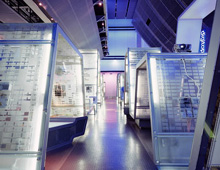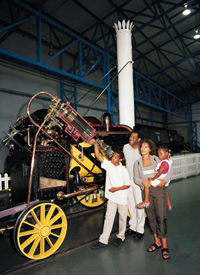 Museums are where glories in the past are recorded. In Science Museum and Natural History Museum, you can find the secrets of nature and a world that existed before the first human started to walk. In National Railway Museum and National Space Centre, you can find how technology has changed this world and the world beyond this planet.
Museums are where glories in the past are recorded. In Science Museum and Natural History Museum, you can find the secrets of nature and a world that existed before the first human started to walk. In National Railway Museum and National Space Centre, you can find how technology has changed this world and the world beyond this planet.
Science Museum
The Science Museum on Exhibition Road, South Kensington, London, is part of the National Museum of Science and Industry. The museum is a major London tourist attraction.
The Science Museum now holds a collection of over 300,000 items, including such famous items as Stephenson's Rocket, Puffing Billy (another early locomotive), the first jet engine, a reconstruction of Francis Crick and James Watson's model of DNA, some of the earliest remaining steam engines, a working example of Charles Babbage's Difference engine, and the first prototype of the 10,000-year Clock of the Long Now. It also contains hundreds of interactive exhibits. A recent addition is the IMAX 3D Cinema showing science and nature documentaries, some of them in 3-D. Entrance has been free since December 1, 2001.
The museum also houses some of the many objects collected by Henry Wellcome around a medical theme. These are displayed up on the 4th and 5th floors, although the objects on display are a fraction of the overall collection. The Science Museum has a dedicated library, and until the 1960s was Britain's National Library for Science, Medicine and Technology. It holds runs of periodicals, early books and manuscripts, and is used by scholars world-wide.
National Railway Museum
The National Railway Museum (NRM) in York forms part of the British National Museum of Science and Industry.
The NRM contains a collection of over 100 locomotives and nearly 200 other items of rolling stock, together with many hundreds of thousands of other items of railway historical interest (down to a lock of Robert Stephenson's hair) displayed in three large halls of a former motive power depot next to the East Coast Main Line, near York railway station. The permanent display includes "Palaces on Wheels", a collection of Royal Train coaches from Queen Victoria's early trains to those used by Queen Elizabeth II up to the 1970s.
All items of rolling stock exhibited either ran on the railways of Great Britain or were built there, with the single exception of a Japanese "Series 0" Shinkansen bullet train leading vehicle, which was donated to the NRM by the JR West railway company in 2001 and which now forms part of an award-winning display.
Natural History Museum
The Natural History Museum is one of three large museums on Exhibition Road, South Kensington, London (the others are the Science Museum and the Victoria and Albert Museum). The museum is home to life and earth science collections comprising some 70 million items. There are five main collections: Botany, Entomology, Mineralogy, Palaeontology and Zoology. There is also a wildlife garden containing native fauna and flora.
The museum is renowned for its exhibition of dinosaur skeletons, particularly the large Diplodocus cast which dominates the entrance.
The newly-developed Darwin Centre (named after Charles Darwin) holds a collection of millions of preserved specimens, interactive materials and new workspaces for the Museum's scientific staff. Lectures and demonstrations occur daily, and are sometimes webcast. The shared space is designed to bring visitors into close contact with working scientists.
National Space Centre
The National Space Centre is one of the United Kingdom's leading visitor attractions devoted to space science and astronomy. It is located in the city of Leicester, England, next to the River Soar. It opened to the public on 30 June 2001.
The centre has six main galleries:
Into Space covers most space hardware, from the rockets that take probes and humans into space, to the specially packaged food humans can eat during their stay. The gallery also includes a life-size mock-up of the European Space Agency's International Space Station Columbus module.
Exploring The Universe covers some of the most exotic space topics, from black holes to the age of the universe.
The Planets gallery covers everything in our Solar System. It houses a real piece of Moon rock, brought back by the astronauts of the Apollo 17 mission, and a sizable Martian meteorite.
Orbiting Earth tells the story of how humans use satellites to improve their daily lives - from telecommunication to forecasting the weather.
Space Now is a live gallery that brings visitors "today's news from space". The gallery hosts live demonstrations, and the news desk provides visitors with an opportunity to ask any space-related questions that puzzle them. The gallery is accompanied by Space Now, a space news website.
Tranquillity Base opened in July 2005, and allows visitors to experience what it would be like to live in a lunar base in the year 2025. Visitors will be trained as astronauts working for AESA - the All Earth Space Agency.
点击查看本频道更多精彩内容